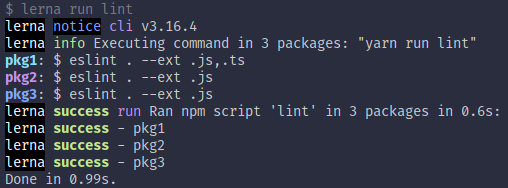

Currently there is no way to throw a warning in this scenario.
LERNA VS YARN WORKSPACES DOWNLOAD
However, it will be broken for consumers that pull it from a registry, since the dependency list is now incomplete so they have no way to download the new dependency. If you are preparing your next release and you decided to use a new dependency but forgot to declare it in the package.json file, your tests might still pass locally if another package already downloaded that dependency into the workspace root. This is because some packages actually need to use the previous versions in order to build the new ones (Babel is one of them).īe careful when publishing packages in a workspace. In the example above, if workspace-b depends on a different version than the one referenced in workspace-a’s package.json, the dependency will be installed from npm rather than linked from your local filesystem. If you encounter issues, try using the nohoist option Making assumptions about this layout was already hazardous since the hoisting process is not standardized, so theoretically nothing new here. The package layout will be different between your workspace and what your users will get (the workspace dependencies will be hoisted higher into the filesystem hierarchy).
LERNA VS YARN WORKSPACES INSTALL
If you’re only making changes to a single workspace, use –focus to quickly install sibling dependencies from the registry rather than building all of them from scratch.

Workspaces are stable enough to be used in large-scale applications and shouldn’t change anything from the way the regular installs work, but if you think they’re breaking something, you can disable them by adding the following line into your Yarnrc file: Since it might be tedious to keep track of each of them, this field also accepts glob patterns! For example, Babel reference all of their packages through a single packages/* directive. The workspaces field is an array containing the paths to each workspace. They will never try to support the high-level feature that Lerna offers, but by implementing the core logic of the resolution and linking steps inside Yarn itself we hope to enable new usages and improve performance. Yarn’s workspaces are the low-level primitives that tools like Lerna can (and do!) use.
LERNA VS YARN WORKSPACES CODE
node_modules/pkg-a -> /workspace-a and you will be able to import code from /workspace-a with const pkgA = require("pkg-a") (or maybe import pkgA from "pkg-a" ). This means that if the /workspace-a/package.json name field was "pkg-a", the alias will be the following: You also need to know that the /workspace-a/package.json#name field is used and not the folder name. That’s the trick that allows you to require the package as if it was a normal one! Please note the fact that /workspace-a is aliased as /node_modules/workspace-a via a symlink. It won’t be there unless some other package use it as a dependency.Īnd that’s it! Requiring workspace-a from a file located in workspace-b will now use the exact code currently located inside your project rather than what is published on npm, and the cross-env package has been correctly deduped and put at the root of your project to be used by both workspace-a and workspace-b. Note: don’t look for /node_modules/workspace-b. node_modules/workspace-a -> /workspace-a


 0 kommentar(er)
0 kommentar(er)
